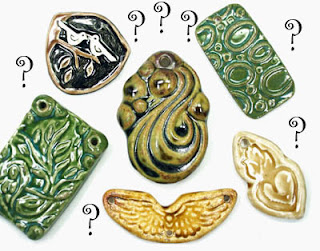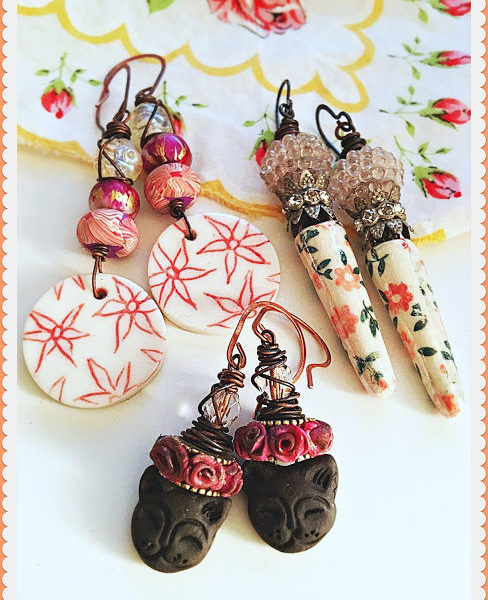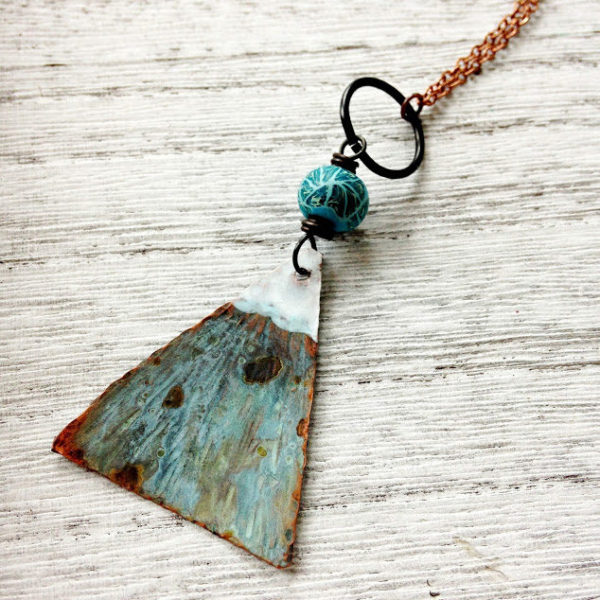
Dear Ms. Bead-It-All,
It’s me again and I am yet again lost. You helped me last month with my vertical holed bead problem, and now I have another problem dealing with bead holes! I have found some wonderful ceramic pendants by a variety of artists. They are quite lovely, but they have holes that go from front to back! How can I use these so that they hang properly on my beaded artworks?
signed again, Lost My Direction
Dear Lost,
Oh dear! With all of your confusion about bead holes it seems you need a map and a compass to enter a bead store! Just teasing, this is actually a common question, especially for bead makers who make such frontally drilled pieces. Why do they do it, then, you ask? Well some materials that artists used can be fragile and temperamental. Items such as glass, ceramic, shell, and wood are all delicate and may not withstand a drilling or piercing horizontally. When a piece is flat and wide, the easiest way to place the hole can be through the shortest section of material, to prevent breakage. Do not worry, there are many creative solutions to this dilemma and here are just a few:
 Heart Flame pendants by Earthenwood Studio
Heart Flame pendants by Earthenwood Studio
#1 (above) Use a simple Lark’s Head knot in the center of a cord.
A simple hitching knot called a Lark’s Head Knot, is one of the simplest ways to attach a frontally drilled pendant to a cord. To tie, fold your cord in half in the middle, and string through the pendant hole, extending an inch or two. Open the loop in the cord, thread the cord ends through the loop, and pull the ends securely. It’s that simple! The size of the cord will depend on the size of the hole. Remember that your cord will have to be doubled through the hole. In this example, the hole was fairly large, so I was able to show microfiber suede, silk ribbon, and silk cord. You can play with multiple thin cords too!
 Bird Pendants by Virginia Miska, Sterling Bails available at Fusion Beads
Bird Pendants by Virginia Miska, Sterling Bails available at Fusion Beads
#2 (above) Use a decorative metal bails for a quick solution.
Many metal bails are available to use for easily converting a frontally drilled pendant for easy stringing. Sterling silver is an ideal material, because it is a soft and pliable metal, but take caution…your bail will only open once or twice before the metal starts to become compromised and risks breakage. So choose wisely! Look for a bail with one or two internal prongs that will fill the hole of the bead, and don’t be afraid to trim those prongs a little if your pendant is thinner than the space between the prongs. Take great care when attaching such a bail and squeeze carefully. Delicate materials like shell and ceramic are likely to chip if they are treated too harshly.
 Ceramic Pendants by Marsha Neal Studio
Ceramic Pendants by Marsha Neal Studio
#3 (above) Make your own metal bail using wireDoing your own wire work is an inexpensive solution to the frontally drilled pendant problem, and one that provides for additional creative opportunities. Use a soft, high quality wire such as sterling or gold-filled, and use some caution when applying your metal and pliers to the pendant. Shown here are a simple wrap, a more elaborate wrap with two wire spirals, and a wrap with an additional bead wired between the bail and the pendant.
 Goddess Tablet by Earthenwood Studio, Hollow glass beads by Rejiquar
Goddess Tablet by Earthenwood Studio, Hollow glass beads by Rejiquar
#4 (above) Use cord and some well placed knots to center your pendant
You may find a pendant with double frontally drilled holes, which happen to be on the smaller side. The holes int he pendant shown here would only accommodate a thinner cord, in this case a waxed cotton cord. Using thinner cord can be an advantage design-wise, and here it was used doubled throughout the necklace for a multi-strand effect. Knots placed atop the first bead section secured the pendant tightly and securely. The cords were then alternately separated for stringing and brought together for knotting, creating a chunky, textural feel to the necklace.
 Sea Swoosh Pendant by Earthenwood Studio
Sea Swoosh Pendant by Earthenwood Studio
#5 (above) Use seed beads to make a beaded bail.
Another way to make your own bail is to use tiny beads such as seed beads to create a beaded bail. Seed beads are wonderful because they come in so many colors and sizes, are inexpensive, and add great detail to beading. For the bail used in this example, size 8 and size 11 seed beads were alternated on flexible cable wire, with the ends of the cable criss-crossed through a crimp in back to create a loop of seed beads onto the pendant. The pendant could then be string onto a beaded necklace, cord, or chain.
 Wingspan and other components by Earthenwood Studio
Wingspan and other components by Earthenwood Studio
#6 (above) Use seed beads to incorporate pendant into necklace.While we are on the topic of seed beads, here is an example of seed beads and accent beads weaving almost seamlessly in and out of a front drilled pendant (this one with three holes!) Notice the use of multiple crimps, which are hidden under the crimp covers, which look like little silver balls. Repeating the same seed bead throughout the necklace makes for a perfectly integrated solution, with endless possibilities for creativity.
I hope that these ideas have given you something to consider, and make the prospect of using those frontally drilled pendants a little less confusing!
happy beading, everyone!…*Ms. Bead-It-All*
p.s. Ms Bead-It-All reluctantly admits to not knowing *every* solution to *every* beading problem… If you can think of another solution to the question at hand, please share with us and your fellow beaders! We invite you to leave a comment here. Or write about it in your own blog. Let us know about your post and we will link to it!
Ms. Bead-It-All is the sassy alter ego of Melanie Brooks Lukacs, the ceramic beadmaker of
Earthenwood Studio, who
blogs from her Metro Detroit, Michigan home.

 Heart Flame pendants by Earthenwood Studio
Heart Flame pendants by Earthenwood Studio Bird Pendants by Virginia Miska, Sterling Bails available at Fusion Beads
Bird Pendants by Virginia Miska, Sterling Bails available at Fusion Beads Ceramic Pendants by Marsha Neal Studio
Ceramic Pendants by Marsha Neal Studio Goddess Tablet by Earthenwood Studio, Hollow glass beads by Rejiquar
Goddess Tablet by Earthenwood Studio, Hollow glass beads by Rejiquar  Sea Swoosh Pendant by Earthenwood Studio
Sea Swoosh Pendant by Earthenwood Studio Wingspan and other components by Earthenwood Studio
Wingspan and other components by Earthenwood Studio


Heather Powers
April 13, 2007 at 2:32 pmgreat solutions Ms. Bead-it All!